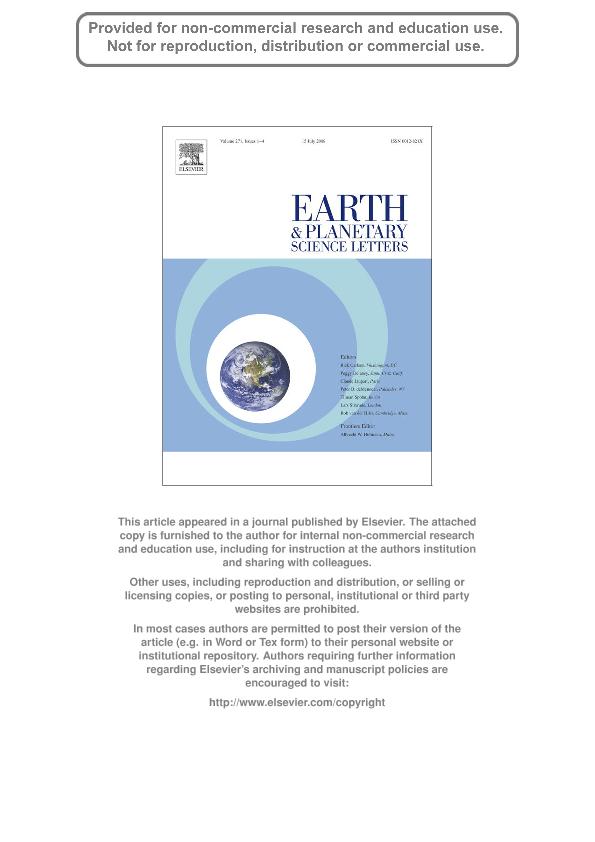Mostrar el registro sencillo del ítem
dc.contributor.author
Somoza, Ruben

dc.contributor.author
Zaffarana, Claudia Beatriz

dc.date.available
2019-06-14T17:56:59Z
dc.date.issued
2008-07
dc.identifier.citation
Somoza, Ruben; Zaffarana, Claudia Beatriz; Mid-Cretaceous polar standstill of South America, motion of the Atlantic hotspots and the birth of the Andean cordillera; Elsevier Science; Earth and Planetary Science Letters; 271; 1-4; 7-2008; 267-277
dc.identifier.issn
0012-821X
dc.identifier.uri
http://hdl.handle.net/11336/78355
dc.description.abstract
A paleomagnetic study on mid-Cretaceous rocks from the San Bernardo foldbelt (Patagonia) yields high unblocking temperature and high-coercivity magnetizations. The results indicate absence of relative vertical-axis rotations during development of the foldbelt, with the associated pole position being highly concordant with coeval poles from Brazil and Patagonia. Taken together, mid-Cretaceous poles derived from studies in widely distributed localities provide supportive evidence that South America was essentially motionless with respect to the paleomagnetic axis from ca 125 to at least 100 Ma. The paleolatitudes of South America are not consistent with the occurrence of mid-Cretaceous true polar wander, suggesting that the previously observed discrepancy between the paleomagnetic and the fixed Indo-Atlantic hotspot reference frames be related to motion of the Atlantic hotspots. In agreement with this, the discrepancy is diminished by half when the Cretaceous poles of the Americas are observed in a moving-hotpots reference frame, with the residual offset being comparable to that seen for younger time intervals. The South American paleopoles and the moving-hotspot framework provide a kinematic scenario that allows relating the extensional tectonics in the early stages of Andean evolution with episodic divergence between the trench and the continental interior. Likewise, the beginning of contractional events correlates with model-predicted westward acceleration of South America in the Late Cretaceous, suggesting that the continent episodically overrode the Andean trench by those times. We argue that this change in Andean tectonic regime is associated to major plate reorganization at ca 95 Ma. © 2008 Elsevier B.V. All rights reserved.
dc.format
application/pdf
dc.language.iso
eng
dc.publisher
Elsevier Science

dc.rights
info:eu-repo/semantics/openAccess
dc.rights.uri
https://creativecommons.org/licenses/by-nc-sa/2.5/ar/
dc.subject
Andes
dc.subject
Hotspots
dc.subject
Mid-Cretaceous
dc.subject
Paleomagnetism
dc.subject
South America
dc.subject.classification
Paleontología

dc.subject.classification
Ciencias de la Tierra y relacionadas con el Medio Ambiente

dc.subject.classification
CIENCIAS NATURALES Y EXACTAS

dc.title
Mid-Cretaceous polar standstill of South America, motion of the Atlantic hotspots and the birth of the Andean cordillera
dc.title
b Departamento de Ciencias Geológicas, FCEyN, Universidad de Buenos Aires, Argentina
dc.type
info:eu-repo/semantics/article
dc.type
info:ar-repo/semantics/artículo
dc.type
info:eu-repo/semantics/publishedVersion
dc.date.updated
2019-04-23T14:41:01Z
dc.journal.volume
271
dc.journal.number
1-4
dc.journal.pagination
267-277
dc.journal.pais
Países Bajos

dc.journal.ciudad
Amsterdam
dc.description.fil
Fil: Somoza, Ruben. Consejo Nacional de Investigaciones Científicas y Técnicas. Oficina de Coordinación Administrativa Ciudad Universitaria. Instituto de Geociencias Básicas, Aplicadas y Ambientales de Buenos Aires. Universidad de Buenos Aires. Facultad de Ciencias Exactas y Naturales. Instituto de Geociencias Básicas, Aplicadas y Ambientales de Buenos Aires; Argentina
dc.description.fil
Fil: Zaffarana, Claudia Beatriz. Consejo Nacional de Investigaciones Científicas y Técnicas. Oficina de Coordinación Administrativa Ciudad Universitaria. Instituto de Geociencias Básicas, Aplicadas y Ambientales de Buenos Aires. Universidad de Buenos Aires. Facultad de Ciencias Exactas y Naturales. Instituto de Geociencias Básicas, Aplicadas y Ambientales de Buenos Aires; Argentina
dc.journal.title
Earth and Planetary Science Letters

dc.relation.alternativeid
info:eu-repo/semantics/altIdentifier/doi/http://dx.doi.org/10.1016/j.epsl.2008.04.004
dc.relation.alternativeid
info:eu-repo/semantics/altIdentifier/url/https://www.sciencedirect.com/science/article/pii/S0012821X08002562
Archivos asociados
